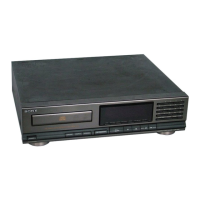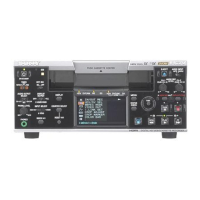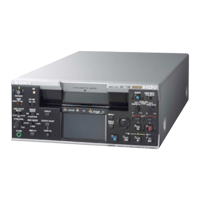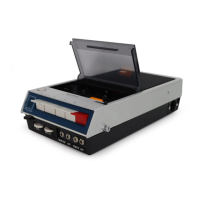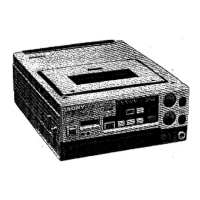Do you have a question about the Sony Model TC-WE405 and is the answer not in the manual?
Warning against exposing the unit to rain or moisture to prevent fire or shock hazards.
Instructions for unpacking the tape deck and verifying all included items.
Guide on connecting the tape deck to an amplifier and setting the correct voltage.
Steps to start tape playback, including inserting cassettes and selecting playback.
Settings for controlling playback direction: one side, both sides continuously, or relay.
Explanation of the Dolby Noise Reduction system for enhanced audio quality.
Setting the tape direction for recording: one side or both sides.
Steps to start the recording process, including inserting a cassette and pressing the REC button.
Using DOLBY NR and adjusting the REC LEVEL for optimal recording.
Guide to manually setting the recording level using the REC LEVEL control for desired sound quality.
How the Auto Rec Level function automatically sets recording levels based on peak signals.
How to cancel the Auto Rec Level function and scenarios for manual adjustment.
Tips for achieving the best recording levels by adjusting during specific parts of the source.
Gradually increasing (fade-in) or decreasing (fade-out) recording levels.
How to copy tapes from deck A to deck B at normal or high speed.
Choosing recording direction and speed (normal/high) for tape dubbing.
Inserting 4-second blank spaces or erasing unwanted portions during recording.
Method for inserting blank spaces longer than 4 seconds by holding the REC MUTE button.
Important safety guidelines regarding disassembly, liquid exposure, and power handling.
Notes on proper operation, placement, and environmental considerations for the tape deck.
How to protect recordings by breaking out record-protect tabs on cassettes.
Best practices for handling cassettes to maintain sound quality and prevent damage.
Procedure for demagnetizing tape heads to maintain sound quality and frequency response.
Instructions for cleaning the heads, pinch rollers, and capstans to prevent performance issues.
Solutions for button malfunctions, including checking cassette insertion and power status.
Diagnosing and fixing issues like no playback, no record, or tape slack.
Addressing issues like wow, flutter, drop-out, decreased level, or noise.
Resolving hum, noise, or unbalanced tone by checking placement and Dolby NR settings.
Details on system recording, fast-winding time, power requirements, and consumption.
Technical data including AC bias, signal-to-noise ratio, harmonic distortion, and frequency response.
Specifications for line inputs, line outputs, and headphone output.
Warning against exposing the unit to rain or moisture to prevent fire or shock hazards.
Instructions for unpacking the tape deck and verifying all included items.
Guide on connecting the tape deck to an amplifier and setting the correct voltage.
Steps to start tape playback, including inserting cassettes and selecting playback.
Settings for controlling playback direction: one side, both sides continuously, or relay.
Explanation of the Dolby Noise Reduction system for enhanced audio quality.
Setting the tape direction for recording: one side or both sides.
Steps to start the recording process, including inserting a cassette and pressing the REC button.
Using DOLBY NR and adjusting the REC LEVEL for optimal recording.
Guide to manually setting the recording level using the REC LEVEL control for desired sound quality.
How the Auto Rec Level function automatically sets recording levels based on peak signals.
How to cancel the Auto Rec Level function and scenarios for manual adjustment.
Tips for achieving the best recording levels by adjusting during specific parts of the source.
Gradually increasing (fade-in) or decreasing (fade-out) recording levels.
How to copy tapes from deck A to deck B at normal or high speed.
Choosing recording direction and speed (normal/high) for tape dubbing.
Inserting 4-second blank spaces or erasing unwanted portions during recording.
Method for inserting blank spaces longer than 4 seconds by holding the REC MUTE button.
Important safety guidelines regarding disassembly, liquid exposure, and power handling.
Notes on proper operation, placement, and environmental considerations for the tape deck.
How to protect recordings by breaking out record-protect tabs on cassettes.
Best practices for handling cassettes to maintain sound quality and prevent damage.
Procedure for demagnetizing tape heads to maintain sound quality and frequency response.
Instructions for cleaning the heads, pinch rollers, and capstans to prevent performance issues.
Solutions for button malfunctions, including checking cassette insertion and power status.
Diagnosing and fixing issues like no playback, no record, or tape slack.
Addressing issues like wow, flutter, drop-out, decreased level, or noise.
Resolving hum, noise, or unbalanced tone by checking placement and Dolby NR settings.
Details on system recording, fast-winding time, power requirements, and consumption.
Technical data including AC bias, signal-to-noise ratio, harmonic distortion, and frequency response.
Specifications for line inputs, line outputs, and headphone output.
| Brand | Sony |
|---|---|
| Model | Model TC-WE405 |
| Category | Cassette Player |
| Language | English |

